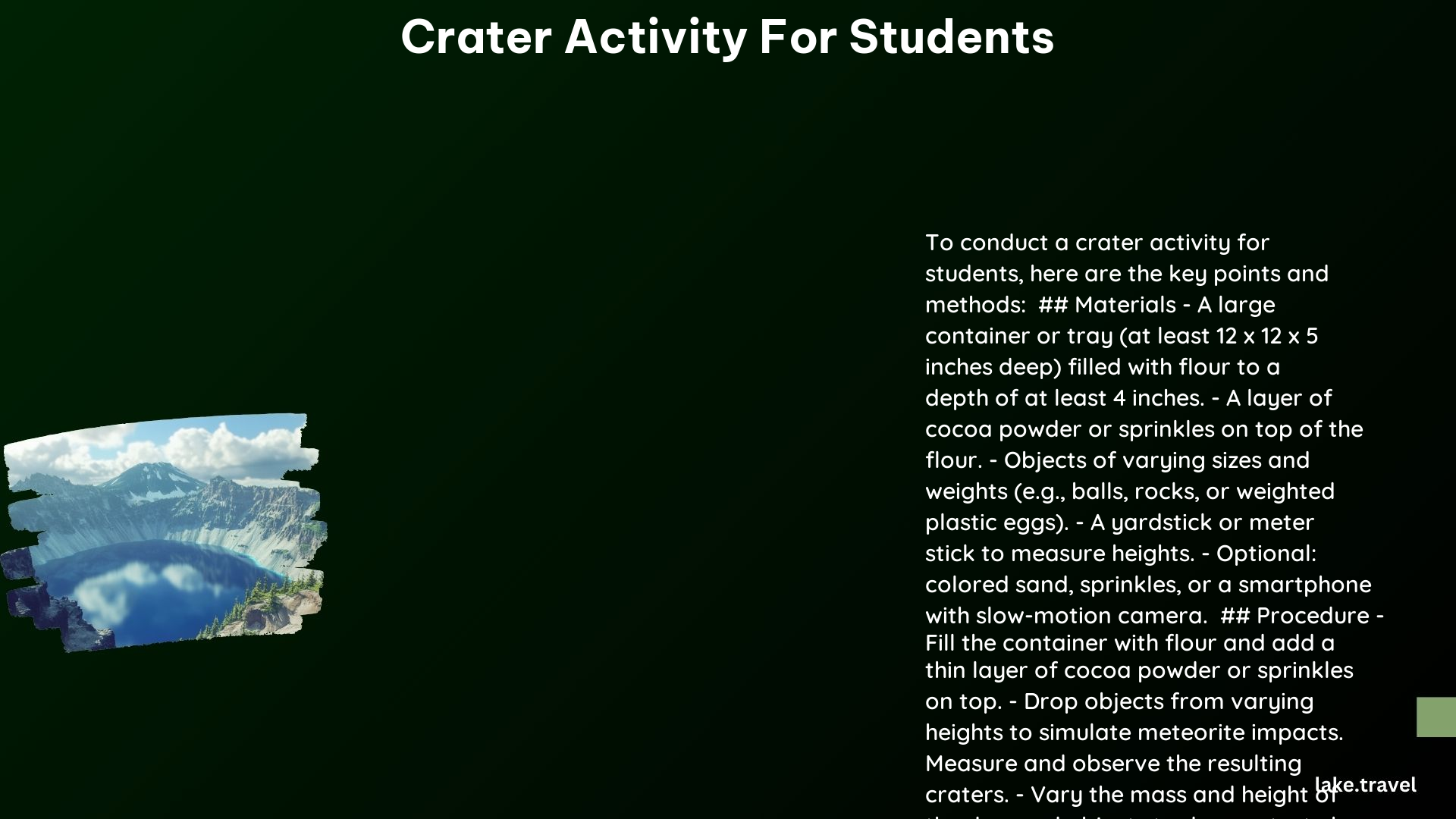Crater activities for students offer hands-on learning experiences about geological and astronomical phenomena. These engaging experiments allow students to explore crater formation, impact dynamics, and lunar surface features. From simple flour-based simulations to more complex variable analysis, crater activities cater to various age groups and educational objectives, making them an excellent tool for science education.
What are the Key Objectives of Crater Activities for Students?

Crater activities for students aim to:
- Demonstrate the process of crater formation
- Illustrate the effects of different variables on crater size and shape
- Teach concepts of energy transfer and impact dynamics
- Enhance understanding of lunar and planetary surfaces
- Develop scientific inquiry and observation skills
How to Plan Crater Activities for Different Age Groups?

Preschool to Early Elementary (Ages 4-7)
Cosmic Craters Activity
Objective: Introduce basic concepts of crater formation
Materials:
– Baking dishes
– Flour
– Marbles, ping pong balls, tennis balls
– Ruler or tape measure
– Clay or playdough
– Paper plates
Procedure:
1. Fill baking dishes with flour
2. Drop objects from various heights
3. Observe and measure crater formations
4. Create clay models of craters
Duration: 45-60 minutes
Safety Tips:
– Handle materials gently
– Avoid throwing objects
Late Elementary to Middle School (Ages 8-13)
Crater Creations Experiment
Objective: Understand the impact of mass, shape, velocity, and angle on crater formation
Materials:
– Large pans or boxes
– Sand, sugar, rice, or oatmeal
– Flour
– Various impactors (marbles, golf balls, rocks)
– Ruler
– Safety glasses
Procedure:
1. Layer sand and flour in pans
2. Drop impactors from different heights and angles
3. Measure and record crater dimensions
4. Analyze the effects of different variables
Duration: 30-45 minutes
Safety Guidelines:
– Wear safety glasses
– Maintain safe distance when dropping impactors
What Advanced Crater Activities Can Be Done with Older Students?
Middle School to High School (Ages 11-18)
Variable Analysis in Crater Formation
Objective: Analyze multiple variables affecting crater formation
Procedure:
1. Conduct experiments changing one variable at a time
2. Predict, measure, and record crater dimensions
3. Discuss findings and relate to real-world crater formation
Duration: 45-60 minutes
Volcanic Crater Modeling
Objective: Understand volcanic crater formation
Materials:
– Baking soda
– Vinegar
– Clay or modeling dough
– Container or tray
Procedure:
1. Create a model volcanic crater using clay
2. Simulate eruption with baking soda and vinegar reaction
3. Observe and discuss crater formation
Duration: 45-60 minutes
What are the Best Practices for Conducting Crater Activities?
- Preparation: Ensure all materials are ready before starting
- Cleanup: Use tarps or ground cloths for easy cleanup
- Engagement: Encourage questions and predictions from students
- Safety: Supervise students and enforce safety guidelines
- Documentation: Have students record observations and measurements
- Discussion: Relate activities to real-world crater formations
How to Adapt Crater Activities for Remote Learning?
- Create video demonstrations of experiments
- Provide a list of household materials for at-home experiments
- Use virtual simulations or interactive online tools
- Conduct live virtual sessions for Q&A and discussions
- Assign crater observation projects using online lunar maps
What are the Learning Outcomes of Crater Activities?
| Age Group | Key Learning Outcomes |
|---|---|
| 4-7 years | Basic understanding of crater formation |
| 8-13 years | Effects of variables on crater size and shape |
| 11-18 years | Advanced analysis of impact dynamics and energy transfer |
How to Assess Student Learning from Crater Activities?
- Observation Sheets: Have students record their observations and measurements
- Prediction vs. Results: Compare initial predictions with actual outcomes
- Group Presentations: Let students present their findings and conclusions
- Quiz or Short Answer Questions: Test understanding of key concepts
- Creative Projects: Assign crater-related art or writing projects
By incorporating these crater activities for students, educators can provide engaging, hands-on experiences that enhance understanding of geological and astronomical concepts while developing critical thinking and scientific inquiry skills.
References:
1. [Cosmic Craters – Preschool STEM Lesson Plan – Space Racers]
2. [Crater Creations – Explore Mars – Activities for Kids – cefls – LibGuides]
3. [Making Moon Craters – Activity – TeachEngineering]
